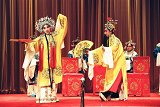表演活動_演出回顧
閑情度曲-崑曲社在師大的點點滴滴
崑曲原稱「崑山腔」,在宋元之際產生於江蘇崑山一帶。經過明代魏良輔等人的改良,使崑腔逐漸成為樂壇、劇壇的主流。清代以後興起的各地方劇種幾乎都直接或間接的受到崑曲的影響,如京、川、越等劇,他們吸收崑曲藝術的滋養,而成就今日的地位。也因此,崑曲有「百戲之母」的稱號。在其他戲曲興起之後,崑曲仍然佔有很重要的地位,各地的文人雅士經常組織曲會,崑曲成為文人日常生活中重要的一部份。
民國四十五年,臺灣師範大學崑曲研究社成立,經歷年年的學習和公演,如今已有五十年的歷史。本次演出由師大崑曲社過去及現在的社員共同配合,並呈現本社五十年來的努力成果。
Kun opera was initially called as "kun-shan's accent" and originated from area of kun-shan, jiang-su during the dynasties of Sung and Yuan. Through refinement by such as Wei Liang-Fu etc. during the dynasty of Ming, kun's accent was gradually becoming of the mainstream of the fields of music and drama. The genres of local drama everywhere in Chinese, such as Peking opera, Szechwan opera, yueh opera etc., arose from after the dynasty of Chin were almost effected directly or indirectly by kun opera. Those genres were nurtured by the art of kun opera to reach the position as today's. As so, kun opera has been called as "mother of hundred genres of drama." After the rise and development of other dramas, kun opera are still holding an important position, and literati and persons with fine tastes frequently organize society of kun opera as the kun opera still plays a significant part of the daily life of those literati.
This performance would be under a common cooperation by the previous and current members under the club for study of kun opera under NTNU and present the outcome after efforts of 50 years by our group.


